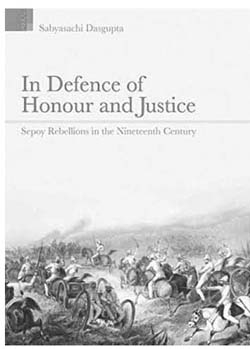Almost all studies of the colonial Indian military establishment which impinge on the relationship between the British and Indian personnel of the colonial Indian armed forces focus attention on the existential crisis of the colonial subjects in military uniform. This existential crisis arose from the peculiar colonial circumstances which governed the lives and societies of these, to use a cliched term, peasants in uniform. There is no dearth of books and articles written on the subject of obedience and disobedience among the Indians who served as soldiers and junior officers first in the three Presidency Armies and later in the Indian Army. Many of these narratives are mentioned and discussed in the Introduction by Dasgupta. Since the colonial armies raised in India by the British were not national armies in the strict sense of the term, mutiny was never far from duty in them. In the eighteenth and nineteenth centuries the British raised and managed to effectively use a variety of Indian armed forces in their colonial interest but, as the book under review states, they could only do so by constantly negotiating and re-negotiating the terms on which the native Indian troops were willing to serve their colonial superiors. The agency of the sepoy is revealed to the historian who researches this process of negotiation.
The book also underlines an important fact governing the Indian soldier’s service to the Company Bahadur. The monetary incentive was certainly important to elicit a positive response from the colonial martial types but equally, if not more, important were the issues of honour and justice because almost all sepoy rebellions which occurred in the nineteenth century were caused when the rebels felt that these two virtues of soldiering had been violated by the British beyond the point of redress. The book highlights the importance of analysing the day-to-day actions of defiance indulged in by the sepoys and native officers in order to perceive the sepoys as active agents of a history which continued to happen in the sepoy armies. It calls for a ‘wider understanding of mutinies’ which were often underpinned by less dramatic acts of disobedience which characterized the mundane functioning of the sepoy armies (p. 115). This tightly written book shows why and how the sepoys broke the ‘psychological barrier erected by the professional training to obey unquestionably’ (p. 115).
The book is divided into five well balanced chapters. The first describes some important mutinies of the nineteenth century beginning with the much researched Vellore Mutiny (1806) and ending with the Great Revolt of 1857. In between are sections on the less known Quilon Mutiny (1812) and a period of transition aptly called the Turbulent 1840s. The second chapter describes the notions of honour and justice which were dear to the sepoys; serving the Company comprised a social contract as far as the sepoys were concerned. This meant that deference was ‘conditional and any arbitrary assertion of authority was a violation of the terms of the moral economy’ (p. 56). Chapter three looks at some important aspects of the sepoy armies like mercenary service, paternalism, religion and caste. The three Presidency Armies present interesting differences with respect to these.

